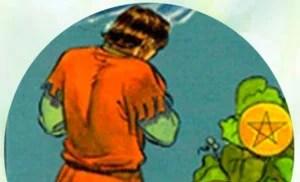Khatyn is a story of tragedy. Ordinary fascism
Has affected me too much strong impression. However, I consider it unethical to ignore this place, this page in the history of our country. The tragedy of Khatyn should be known and remembered by me, and you, and everyone.
I’ll say right away that I have not been to Khatyn and do not plan to visit it in the near future. We have to come to this; personally, I’m not ready yet. Please do not treat this place as a landmark of Belarus, a weekend trip, an excursion for the sake of impressions. Khatyn is not tourism. It's much bigger and deeper. This is one story of horror and evil that man is capable of inflicting on man. But there were hundreds of them, stories...
- Official website: http://www.khatyn.by/
- Phones: +375 17 74 55787 (MMC "Khatyn"), +375 17 5071076 (MK " ")
- Ticket price
- How to get to Khatyn on the map
The tragedy of Khatyn. 1943, March 22
Known to the world terrible tragedy Khatyn, which occurred during the Great Patriotic War, which was wiped off the face of the earth on March 22, 1943. On this spring day, fascist monsters, seeking revenge for the attack on their convoy by partisans, approached the village. As a result of the shelling of the convoy, a Nazi officer was killed, and Khatyn was only 6 km from the site of the partisan ambush. Local residents had nothing to do with the sabotage, but the Germans did not care at all. They didn’t care about their lives: neither children, nor old people, nor women. Everyone who was in Khatyn that day was driven and locked in a collective farm barn - more than 150 people, half of whom were children and teenagers.

After making sure that all the villagers were in the barn, the Nazis closed it and covered it with straw. Then, preparing to shoot if anyone managed to get out, they doused the barn with gasoline and set it on fire. Distraught from the smoke and fire, people screamed and cried. The children tried to find salvation from their parents. Horror and the desire to live forced the burned people, with their clothes on fire, to break down the doors. But the Nazis, acting with savage cruelty, shot everyone escaping from the fiery hell. Having finished killing, the Nazis plundered the houses and burned them, leaving only ashes of Khatyn.
The Nazis thought that there was not a single witness to their atrocities. But three residents miraculously managed to survive. These were two boys who were in the barn during the tragedy - Viktor Zhelobkovich and Anton Baranovsky. Vita was only 7 years old at the time, Anton was 12. After the Nazis left the village, residents of neighboring villages came there and found them barely alive from wounds and burns. The children were released, after the war they grew up in orphanage.

Another survivor is 56-year-old Joseph Kaminsky, a local blacksmith. When he, wounded, came to his senses, the punitive forces had already left Khatyn. Having begun to look for relatives in the ashes, Kaminsky found his son, who was seriously wounded and died in his father’s arms. This moment is reflected in the memorial monument to all those who died in Khatyn.
Khatyn. The history of the tragedy - we must remember!
In 1966, the leadership of Belarus decided to perpetuate the memory of all those who died during the Great Patriotic War. It was decided to create a memorial that would remind all future generations what the sacrifices of the Belarusian people were in that war in the Logoisk region and give it the name “Khatyn”.
The monument was built, one might say, by the entire Union. The materials for its manufacture were imported from Ukraine and Russia. The bulk of the work was completed by the end of 1968, and the opening of the memorial took place in July 1969.
The opening ceremony of the Khatyn memorial complex began from Victory Square in the capital of Belarus - Minsk. In the presence of city residents, veterans of the Great Patriotic War, guests from the Union republics and other countries, a torch was lit from the Eternal Flame. After this, the fire was transported to Khatyn in an armored personnel carrier, accompanied by an honorary escort. A huge number of people gathered in Khatyn - participants in a solemn funeral meeting. The surviving residents of the burned Khatyn also took part in the ceremony - tragedy, sorrow and pride for their people could be read in their eyes...
The history of Khatyn in the idea of a memorial
The memorial in memory of the history of Khatyn reflects all the bitterness of grief for the victims. After all, more than a quarter of the inhabitants of Belarus died during the Nazi occupation. At the same time, the monument shows that the human will is stronger than any atrocities and violence against people. The image of a father carrying his dead son in his arms says that although the Nazis killed them, they could not conquer them.

The idea of the memorial is a feeling of not only grief, but also pride for everyone who did not submit to the invaders. Everyone knows how great the resilience and heroism of the Belarusian people were in the fight against the Nazis. At the same time, the greatest tragedy and enormous courage are intertwined in an outstanding artistic and architectural structure. It carries both a deep meaning and at the same time simplicity of its perception. It depends only on us whether we want to understand him and make sure that the Khatyn tragedy never happens again.
(Visited 2,087 times, 1 visits today)
This happened on March 22, 1943 . The brutal fascists burst into Khatyn village and surrounded her. The villagers did not know anything that in the morning, 6 km from Khatyn, partisans fired at a fascist convoy and as a result of the attack, a German officer was killed. But the Nazis have already sentenced innocent people to death. The entire population of Khatyn, young and old - old people, women, children - were kicked out of their homes and driven into a collective farm barn. The butts of machine guns were used to lift the sick and old people out of bed; they did not spare women with small and infant children. The families of Joseph and Anna Baranovsky with 9 children, Alexander and Alexandra Novitsky with 7 children were brought here; there were the same number of children in the family of Kazimir and Elena Iotko, the youngest was only one year old. Vera Yaskevich and her seven-week-old son Tolik were driven into the barn. Lenochka Yaskevich first hid in the yard, and then decided to take safe refuge in the forest. The Nazis' bullets could not catch up with the running girl. Then one of the fascists rushed after her, caught up with her, and shot her in front of her father, distraught with grief. Together with the residents of Khatyn, Anton Kunkevich, a resident of the village of Yurkovichi, and Kristina Slonskaya, a resident of the village of Kameno, were driven into the barn, who at that time found themselves in Khatyn village .
Not a single adult could go unnoticed. Only three children - Volodya Yaskevich, his sister Sonya and Sasha Zhelobkovich - managed to escape from the Nazis. When the entire population of the village was in the barn, the Nazis locked the doors of the barn, lined it with straw, doused it with gasoline and set it on fire. The wooden barn instantly caught fire. Children were suffocating and crying in the smoke. The adults tried to save the children. Under the pressure of dozens human bodies The doors could not stand it and collapsed. In burning clothes, gripped by horror, people rushed to run, but those who escaped from the flames were shot in cold blood by the Nazis from machine guns and machine guns. 149 village residents burned alive in the fire, including 75 children under 16 years of age. The village was plundered and burned to the ground.
Two girls from the Klimovich and Fedorovich families - Maria Fedorovich And Yulia Klimovich - miraculously managed to get out of the burning barn and crawl to the forest. Burnt and barely alive, they were picked up by residents of the village of Khvorosteni, Kamensky village council. But this village was soon burned by the Nazis and both girls died.
Only two of the children in the barn survived - seven-year-old Viktor Zhelobkovich and twelve-year-old Anton Baranovsky. When terrified people were running out of the burning barn in burning clothes, Anna Zhelobkovich ran out along with other village residents. She held her seven-year-old son Vitya tightly by the hand. The mortally wounded woman, falling, covered her son with herself. The child, wounded in the arm, lay under the corpse of his mother until the Nazis left the village. Anton Baranovsky was wounded in the leg by an explosive bullet. The Nazis took him for dead.
The burnt and wounded children were picked up and came out by residents of neighboring villages. After the war, the children were raised in the orphanage of the city. Pleshchenitsy.
The only adult witness to the Khatyn tragedy, 56-year-old village blacksmith Joseph Kaminsky, burned and wounded, regained consciousness late at night, when the Nazis were no longer in the village. He had to endure another severe blow: among the corpses of his fellow villagers, he found his wounded son. The boy was fatally wounded in the stomach and received severe burns. He died in his father's arms.
This tragic moment in the life of Joseph Kaminsky forms the basis for the creation of the only sculpture of the memorial complex "Khatyn" - "The Unconquered Man".
Tragedy of Khatyn - one of thousands of facts testifying to the deliberate policy of genocide towards the population of Belarus, which was carried out by the Nazis throughout the entire period of occupation. Hundreds of similar tragedies occurred during the three years of occupation (1941-1944) on Belarusian soil.




Co school years The word Khatyn remained in my memory; the story of the tragedy of the Belarusian village, which was completely burned by the Nazis, could not leave anyone indifferent. The entire civilian population, mainly women and children, were exterminated in March 1943.
April 16, Saturday, 6th day by car . My car rental expires today at lunchtime. The entire planned excursion program has been completed. Almost done. Somewhere at the very beginning of planning my trip, the thought of visiting the Khatyn memorial complex kept popping up, but according to the map it was not on the route. Therefore, there was no confidence that it would be possible to get there.
8.00 . And this morning I have a few hours, and I make up my mind. On the way I stop at. But you can read a separate story about this amazingly beautiful place.
9.40 . The distance Minsk-Khatyn is 65 kilometers (I calculated the route from my hotel today in Minsk, “Sport Time”). The journey took 45 minutes. How to get here, where Khatyn is located on the map, how much it costs - see all the information at the end of the article.

A beautiful spring morning comes into its own, and I leave my car in a huge and empty parking lot near the Khatyn memorial. At this early hour there is only one car here (besides me).
In front of me is a huge territory of the complex, and all around... silence. It’s so strange, but for some reason the crazy singing of birds and a light breeze in spring are not perceived as extraneous sounds. They are so harmonious here. And it seems that it has always been like this here. This is how it SHOULD always be.
But historical facts are a merciless thing and the story about Khatyn is taking shape. On the very first stone monument there are fresh flowers and scary numbers.
On March 22, 1943, the Nazis destroyed the village of Khatyn with all its inhabitants, and also turned 209 cities and towns, 9,200 villages and hamlets into ruins. In total, 2,230,000 Soviet citizens fell at the hands of the German invaders on the territory of Belarus. This will never be forgotten!

It was at this place that the village of Khatyn began, completely destroyed by the Nazis along with all its inhabitants.
Belarus greeted me with a wonderful period of spring, when the trees are in bloom or the leaves of the marvelous color of young greenery are just emerging. All this created an indescribable range of feelings. The contrast of the blossoming spring and the territory of the memorial complex evoked the deepest emotions of grief, a lump came to my throat.
More than 70 years ago and just one month earlier: in March everything was different here. The slabs I walked on led me into the terrible past of my country. And this past concerned not only my ancestors, but the entire history of mankind as a whole. History came to life before my eyes.
The facts are such that the life of one person can show the rise and fall of an entire nation.
The life and death of track and field athlete Hans Welke
In 1936, the Olympic Games were held in Berlin. It so happened that the first German who was able to receive gold medal in the shot put, track and field athlete Hans Welke became the first in the history of the games.
Every German newspaper and magazine was full of praise for Welke as a representative of the pure Aryan race. At the same time, they did not spare insults and dirt against “some blacks and other anthropoids,” as all other people were called.
But all this hype turned out to be completely in vain, since at the same Olympics, only a few days later, the black Jesse Owens performed magnificently and won as many as 4 gold medals in athletics.
And in the future, pure Aryan blood did not save Hans from the bullet of the Belarusian partisans, when in March 1943 he found himself in a fascist convoy on the territory of occupied Belarus. It was here, near the then unknown village of Khatyn, that fighters of the Avenger partisan detachment killed several policemen and one German officer in a shootout. The company commander was riding in that shot car. It was he - Hauptmann Hans Welke, former Olympic champion in shot put...
Obviously, the death of one purebred Aryan, in the opinion of the fascist punitive forces, cost the life of an entire village. The Germans called for help, and the partisans were forced to retreat. The village was left without protection.
History of the tragedy
By the evening of the same day, the Nazis arrived in Khatyn. All residents: old people and children, men and women, everyone who was in the village at that time, regardless of their condition: sick and pregnant women, women with infants, bayonets and butts, were driven into a wooden collective farm barn with still strong walls. They covered it on all sides with straw and set it on fire.
The dry wooden barn immediately burst into flames like a torch. The children screamed loudly in fear and pain, and the adults, choking in the smoke, tried to save them. The strong doors of the barn could not withstand the pressure of human bodies and collapsed. Frightened people began to jump out, run out, and some began to crawl out of the burning flame. But the fascist punitive forces, without any pity, shot them point-blank with fire from machine guns and machine guns.
In the Khatyn tragedy, all 149 residents died, half of them: 75 people were children. Only three of them managed to hide from the Nazis and avoid the terrible fate of being burned alive: brother and sister Volodya and Sonya Yaskevich, as well as Sasha Zhelobkovich.
But of those in that torch-barn, surprisingly, only two children were able to survive. One boy, Viktor Zhelobkovich, dying mother covered it with herself, and he lay under her corpse until the Germans left. And the Germans simply mistook the second wounded child, Anton Baranovsky, for dead and did not finish him off or shoot him.
Khatyn blacksmith Joseph Kaminsky is the only surviving adult. Wounded, with severe burns, he lay unconscious until late at night. When Joseph woke up, he found his 15-year-old son among the dying. The child was badly burned, but still alive. He had a fatal wound to the stomach. Soon, the boy died in his father's arms.
It is this terrible moment, the moment of the highest mortal pain, that is captured in the sculpture “Unconquered Man”, which became the main key figure memorial complex "Khatyn". Now they are together forever: father and son.

In this terrible tragedy, 54-year-old Joseph Kaminsky lost his entire family: his wife and three children.
During the period of brutal occupation during the Great Patriotic War, the terrible fate of Khatyn was shared by another 628 Belarusian large and small villages, which were burned to the ground by the Nazis along with their inhabitants.
A quarter of them: 186, like Khatyn, were never restored.
I suggest watching a short video about this terrible tragedy.
Khatyn - from a wooden obelisk to a memorial complex of world significance
Immediately after the war on the ashes of these villages for a long time they simply erected wooden obelisks with inscriptions and a red star or small plaster monuments. But the bitter memory turned out to be timeless.
In 1966, the USSR government decided to create a memorial: the Khatyn complex. In 1967, a competition was held for best project monument. Like an unhealed wound, the memory of these dramatic events made it possible for a team of architects consisting of Yuri Gradov, Valentin Zankovich, Leonid Levin and sculptor Sergei Selikhanov to create a masterpiece.

In July 1969, the Khatyn complex was inaugurated for visits and excursions.
Monument "Khatyn" in Belarus
The central figure of the Khatyn monument is represented by the bronze sculpture “Unconquered”. This is a tear-inducing figure of a man, 6 meters high, with the body of a dead child in his arms.
A dark, motionless silhouette, as if blackened by grief and burning. Lit sun rays against the backdrop of a piercing blue sky, it looks especially contrasting.

The place where the barn was burned along with the people is marked with a black slab - representing the roof of that same ill-fated barn.

Nearby there is a mass grave, where the remains of all the residents of the village of Khatyn who were burned alive are buried, with words of instruction on behalf of the dead to us, the living, and a symbolic wreath of memory.

The inscription on the monument reads:
Good people, remember: we loved life and our homeland. And you, dear ones. We burned alive in the fire. Our request to everyone: let grief and sadness turn into your courage and strength, so that you can forever establish peace and tranquility on earth, so that from now on, life will never die anywhere in a whirlwind of fires!
The Khatyn Memorial in its layout resembles a lost village: the arrangement of houses and even wells.
In total, there were 26 houses in the village that were completely burned. Currently, each of them resembles a log house, inside of which there is an obelisk - a chimney.

At the top of each is a bell.

The deep deafening silence of this place is pierced every 30 seconds, day and night, by the simultaneous ringing of all 26 bells of Khatyn.

Here, on each column, there is a board with the names of the inhabitants of this house imprinted forever.

There are also village wells preserved here. More precisely, the places where they once were. Now they are marked by marble roofs, and in the stone slabs there are symbolic recesses where rainwater accumulates.

For some reason people throw money there. It’s unusual to see paper bills floating in the water. Probably because there are no small coins in Belarus yet.


Urns containing soil from 185 villages in Belarus that were devastated and burned to the ground were solemnly delivered here. Khatyn itself was 186th on this mourning list.

On each symbolic grave, the name of the disappeared village is carved into stone. These names can now only be found here. Such names no longer exist on the map of Belarus.
The fascist occupiers wiped them off the face of the earth. And they never recovered. Yes! There is none of them. But they are forever alive in people's memory. Nearby is the Wall of Sorrow.

This is a reinforced concrete wall with niches. People bring flowers and plush toys here.

On these memorial plates, 66 death camps created by the fascist occupiers on the territory of Belarus are immortalized, and the places of death are named large quantity of people.

The memorial has a Memory Square. On it like a symbol eternal life 3 birches grow.

The Eternal Flame burns without going out for a minute.

This is a symbolic reflection of the fact that only 3/4 of the destroyed villages and hamlets were revived to a new life. And a quarter disappeared from the face of the earth forever. So three birch trees grow here, and instead of the fourth, a memorial fire burns.
Nearby is the Tree of Life, symbolizing reborn life.

On its “branches” is a list of those burned by the Nazis, but revived after the war by labor Soviet people, 433 villages...

Khatyn is a symbol of all the villages that were burned by the German conquerors during the Second World War. The history of the Khatyn tragedy has survived to this day. And I really want to hope that it will remain in the hearts and memories of people for many decades and centuries.
This memorial complex is the historical and cultural heritage of Belarus. Thousands of tourists visit it every year. This is one of the most bitter and revered places of the Great People of Belarus. Now there is a piece of my heart there too.
Museum and prices
Next to the parking lot there is a Museum, which displays a photo-documentary exhibition “Khatyn”. In a small room there are historical photographs events that took place on the territory of Belarus during the Great Patriotic War and after it.
Terrible photographs of fascist genocide and victims of occupation. Executions, murders, fires. And post-war footage of those who survived and learned to live again, literally, from scratch.
There are also photos of how the memorial complex was built, how monuments were installed and the Eternal Flame was lit. Here, for example, is a documentary photograph of the symbolic burial of soil from the ashes of Belarusian villages that disappeared from the face of the earth.

The exhibition is small, and the cost of visiting is also: 10,000 Belarusian rubles (35 rubles, or $0.5). I examined her for free, since the caretaker and other workers were drinking tea in the neighboring house in the morning. so entry was free :)
By the way, there is a tour desk in the building nearby, where you can arrange an excursion. Opening hours daily from 10 a.m., closed on Mondays.
You will probably hear many new interesting things as part of the excursion. historical facts. But on this day I was very pleased that I visited this amazingly powerful place in solitude and silence.
Login Memorial Complex"Khatyn" is free. You don't have to pay anything for parking either.
Where is it, how to get there
The historical Khatyn Complex is located on the 54th kilometer of the Minsk-Vitebsk highway (M3 highway north of the Belarusian capital).
After the large stone sign “Khatyn” you need to turn right (if you are coming from Minsk). After 4.5 km there will be a huge parking lot of the complex.
The map can be enlarged to better see the area of the memorial monument.
A leisurely independent inspection of the territory took me exactly 1 hour.
Coordinates: 54.33473, 27.94354.
In Belarus, in any city, there is a huge number of different housing options. It’s very easy to rent an apartment or room on the service, or book a hotel through the service.
The map below shows other sights of Belarus that I was able to visit. You can see more details about each of them.
Having lost the battle of Stalingrad at the beginning of 1943, the German government changed its policy towards the inhabitants of the occupied countries, and after the creation of two Latvian and one Estonian divisions, on April 28, 1943, the Ukrainian SS division “Galicia” was formed.
According to the order of Reichsführer SS Heinrich Himmler dated July 14, 1943, it was forbidden to call it Ukrainian, but only “Galician division.” The full name of the formation is “114th SS Volunteer Infantry Division “Galicia”.
The units of "Galicia" performed mainly police functions. The initiators of the creation of the division abandoned the word “police” for political and psychological reasons. However, the division's soldiers had to take part in battles with regular units Soviet army. In the first battle near Brody, during the Lvov-Sandomierz operation Soviet troops, the Galicia division was completely defeated. Some of its formations later took part in a number of police operations in Eastern and Central Europe.
A year before the formation of the SS division "Galicia", in June 1942, the 118th security police battalion was formed in Kyiv from among former members Kyiv and Bukovina kurens of the Organization of Ukrainian Nationalists (OUN). Vasyura was appointed chief of staff of this battalion, who almost single-handedly led the battalion and its actions.
On March 22, 1943, the 118th security police battalion entered the village of Khatyn and surrounded it.
The entire population of Khatyn, young and old - old people, women, children - were kicked out of their homes and driven into a collective farm barn. The butts of machine guns were used to lift the sick and old people out of bed; they did not spare women with small and infant children. When all the people were gathered in the barn, the punishers locked the doors, lined the barn with straw, doused it with gasoline and set it on fire. The wooden barn quickly caught fire. Under the pressure of dozens of human bodies, the doors could not stand it and collapsed. In burning clothes, gripped by horror, gasping for breath, people rushed to run, but those who escaped from the flames were shot from machine guns. 149 village residents burned in the fire, including 75 children under 16 years of age. The village itself was completely destroyed.
Of the adult residents of the village, only 56-year-old village blacksmith Joseph Kaminsky survived. Burnt and wounded, he regained consciousness only late at night, when the punitive squads left the village. He had to endure another severe blow: among the corpses of his fellow villagers, he found his son. The boy was fatally wounded in the stomach and received severe burns. He died in his father's arms.
I was in Khatyn. Then we examined the entire Memorial architectural and sculptural complex, which occupies an area of about 50 hectares. In the center of the memorial composition is a six-meter bronze sculpture “The Unconquered Man” with a murdered child in his arms.
Nearby are closed granite slabs, symbolizing the roof of the barn in which the villagers were burned. On mass grave made of white marble - Crown of Memory.
The former village street is lined with gray, ash-colored reinforced concrete slabs. In those places where houses once stood, 26 obelisks were erected, reminiscent of chimneys scorched by fire, and the same number of symbolic log buildings made of concrete. On the chimney-obelisks there are bronze plaques with the names of those who were born and lived here. And above are sad ringing bells.

On the territory of the memorial there is also an eternal flame in memory of the victims of Nazi crimes.
Executioners of Khatyn - who are they?
Every nation is proud of the victories achieved in the struggle for the freedom and independence of their homeland, and sacredly respects the memory of the losses suffered in the name of these victories. The French have Oradour, the Czechs have Lidice. The symbol of the immortal trials of the Belarusians is Khatyn, representing 628 Belarusian villages destroyed during the war along with their inhabitants.
“...The bloody tragedy of this forest settlement of 26 households took place on March 22, 1943. 149 people, 76 of them children, remained forever in this hellish grave. All except one - Yosif Yosifovich Kaminsky, who accidentally escaped from a burning barn crowded with people and now appeared in bronze with his dead son in outstretched arms. Everything is in his hands - despair, tragedy, and the endless will to live, which gave the Belarusians the opportunity to survive and win...” wrote Vasily Bykov in the article “The Bells of Khatyn” in 1972.
What do we know about the tragedy of the destroyed Belarusian village? Any schoolchild here can say that Khatyn was burned by German punitive forces... They were considered to be responsible for the tragedy.
Indeed, in the text of the photo album “Khatyn” (Minsk, 1979), the punishers are called “the Nazis, overwhelmed by the manic idea of the “exclusiveness” of the Aryan race, their imaginary “superhumanity.”
The idea of the Khatyn tragedy and the Bolshoi Soviet Encyclopedia, where we read: “Khatyn is a memorial architectural and cultural complex on the site of the former. village of Khatyn (Minsk region of the BSSR). Opened on July 5, 1969 in memory of the Belarusian residents. villages and villages completely destroyed by the Nazis. occupiers" (BSE, M., 1978, T.28, P.217).
What really happened?
In the newspaper “Soviet Youth” No. 34 for March 22, 1991, which was published in Latvia, the article “Khatyn was burned by policemen” (The case of Grigory Nikitovich Vasyura, a native of the Cherkasy region) was published.
It turns out that the village of Khatyn in Belarus was destroyed along with all its inhabitants not by the Germans, but by a special Sonderkommando (118th police battalion), which consisted overwhelmingly of Ukrainian policemen. Yes, yes, Ukrainians!


in two photos there are Ukrainian policemen
The chief of staff of this battalion was Grigory Vasyura, who almost single-handedly led the battalion and its actions.
Now let's move on to finding out the reasons and circumstances that ultimately led to the destruction of the Belarusian village of Khatyn.
After its formation, the 118th police battalion initially established itself “well” in the eyes of the occupiers, taking an active part in mass executions in Kyiv, at the notorious Babi Yar. After this, the battalion was redeployed to the territory of Belarus to fight the partisans. This is where the terrible tragedy occurred, as a result of which Khatyn was destroyed.
The fact is that the position of quartermaster in each of the subsections of this battalion was necessarily occupied by a German officer, who was thus an unofficial supervisor-supervisor of the activities of the police of his subsection. Of course, such rear service was much safer and more attractive than being at the front. Therefore, it is not surprising that one of the German officers Adolf Hitler’s favorite, Hauptmann Hans Welke, found himself in a similar position.
The Fuhrer's love for him was not accidental, since it was he, Hans Welke, who was the first German to win a gold medal in the shot put Olympic Games Ah 1936 in Munich, which thoroughly strengthened the Fuhrer’s thesis about the primacy of the Aryan race.

And it was Hauptmann Hans Welke who, while in ambush, was killed by Soviet partisans who had stopped the night before in the village of Khatyn.
Of course, the murder of the Fuhrer’s favorite made all the policemen greatly worry about the safety of their own skins, and therefore the need for “worthy retribution to the bandits” became a “matter of honor” for them. Unable to find and capture the partisans, the police followed in their footsteps to the village of Khatyn, surrounded it and began executions of the local population in revenge for the murdered Hauptmann.
May 13 Vasyura heads fighting against the partisans in the area of the village. Dalkovichi. On May 27, he carried out a punitive operation in the village. Osovy, where 78 people were shot. Next - the punitive operation "Cottbus" on the territory of the Minsk and Vitebsk regions - reprisals against the residents of the village of Vileika; extermination of the inhabitants of the village of Makovye and shooting near the village of Uborok. Kaminskaya Sloboda 50 Jews. For these “merits” the Nazis awarded Vasyura the rank of lieutenant and two medals.
When his battalion was defeated, Vasyura continued to serve in the 14th SS Grenadier Division "Galicia", already at the very end of the war - in the 76th infantry regiment, which was defeated already in France.
After the war in the filtration camp, he managed to cover his tracks. Only in 1952, for collaboration with the Nazis during the war, the tribunal of the Kyiv Military District sentenced him to 25 years in prison. At that time, nothing was known about his punitive activities. On September 17, 1955, the Presidium of the Supreme Soviet of the USSR adopted the Decree “On amnesty for Soviet citizens who collaborated with the occupiers during the war of 1941-1945,” and Vasyura was released. He returned to his native Cherkasy region.
Where he became deputy director of the state farm. Moreover, he got himself a certificate stating that he was convicted for being captured. This allowed him to officially become a WWII veteran and, accordingly, receive anniversary medals, meet with schoolchildren, receive food packages, etc.
What ruined Vasyura was that in 1985, on the 40th anniversary of the Victory, he began to demand the Order of the Great Patriotic War. Then some minor employee in the archives of the military registration and enlistment office discovered that Vasyura was still listed as missing. They started digging and got to the bottom. It was lucky that at that time they discovered another WWII veteran - a certain Meleshko, who commanded one of the companies of the 118th punitive police battalion. They began to interrogate this Meleshko in Minsk, and he handed over Vasyura, with whom they corresponded after the war.
26 witnesses - punishers from his battalion - were called to Vasyura's trial. They were brought to Minsk from all over the USSR. Each of them had already served his sentence for helping the Germans by that time (the maximum term that one punisher out of these 26 served in Stalin’s camps was 8 years).

The trial of Vasyura lasted 1.5 months, only one journalist was present at the trial - from the newspaper Izvestia. As a result, he made a report about Vasyur, but the newspaper did not publish it “for political reasons.”
A natural question arises: why at that time the case and the trial of the main executioner of Khatyn did not receive adequate publicity in the media? mass media. It turns out, according to one of the researchers of this topic, journalist Glazkov, the top party leaders of Belarus and Ukraine “had a hand” in classifying this case. The leaders of the Soviet republics cared about the inviolability of the international unity of the Belarusian and Ukrainian peoples (!).
The first secretary of the Communist Party Central Committee, member of the Politburo of the CPSU Central Committee, Vladimir Shcherbitsky, was especially active in ensuring the non-disclosure of materials from the Vasyura case. As a result of this pressure, correspondents were only selectively allowed into the process, and subsequently none of the materials prepared by them were ever published.
Dossier:
Vasyura Grigory Nikitovich, born in 1915, Ukrainian, native of the Cherkasy region, from peasant background. A career military man, he graduated from the Communications School in 1937. In 1941, with the rank of senior lieutenant, he served in the Kiev fortified area. As the head of communications for a fortified area of a rifle division, this native of the Cherkasy region was captured in the first days of the war and voluntarily went into service with the Nazis. He graduated from the school of propagandists at the so-called Eastern Ministry of Germany. In 1942 he was sent to the police of occupied Kyiv. Having proven himself to be a zealous servant, he soon became the chief of staff of the 118th police battalion. This unit was distinguished by its particular cruelty in exterminating people at Babi Yar. In December 1942, a punitive battalion was sent to Belarus to fight the partisans.
This was Gregory’s life before and during the war. She looked no less “interesting” afterwards. The description of the deputy director for economic affairs of the Velikodymersky state farm in the Brovary district of the Kyiv region reports that before his retirement and after that, Grigory Vasyura worked conscientiously. In April 1984, he was awarded the Veteran of Labor medal, who was congratulated every year by the pioneers on May 9, and the Kiev military school communications even enrolled as honorary cadets! This was the case until 1986.
In November - December 1986, the trial of Grigory Vasyura took place in Minsk. The 14 volumes of case No. 104 reflected many specific facts of the bloody activities of the fascist punitive force. By the decision of the military tribunal of the Belarusian Military District, Vasyura was found guilty of crimes and sentenced to to the highest degree punishment - execution. During the trial, it was established that he personally killed more than 360 civilian women, old people, and children.
On the issue of Ukrainian participants in the Khatyn action. (
Not on any of the most detailed geographical map you won't find this Belarusian village today. It was destroyed by the Nazis in the spring of 1943.
Khatyn - former village Logoisk district of the Minsk region of Belarus - became a symbol of the tragedy of the Belarusian people, a mournful page in the history of the Great Patriotic War.
On March 22, 1943, a terrible tragedy occurred in the Belarusian village of Khatyn. The 118th security police battalion entered the village of Khatyn and surrounded it. The entire population of Khatyn, young and old - old people, women, children - were kicked out of their homes and driven into a collective farm barn. The butts of machine guns were used to lift the sick and old people out of bed; they did not spare women with small and infant children. When all the people were gathered in the barn, the punishers locked the doors, lined the barn with straw, doused it with gasoline and set it on fire. Not a single adult could go unnoticed. Only three children - Volodya Yaskevich, his sister Sonya Yaskevich and Sasha Zhelobkovich - managed to escape from the Nazis.
Who are the executioners? Interesting Facts

What do we know about those who destroyed the village of Khatyn along with all its inhabitants? It turns out that the village of Khatyn in Belarus was destroyed not by the Germans, but by a special Sonderkommando (118th police battalion), which consisted overwhelmingly of Ukrainian policemen. The battalion was commanded by the former Polish major Smovsky, the chief of staff was the former senior lieutenant of the Red Army Grigory Vasyura, the platoon commander was the former lieutenant of the Red Army Vasily Meleshko. The German "chief" of the 118th auxiliary battalion was Police Major Erich Kerner.
Grigory Vasyura led the punitive operation. Moreover, after the war, he hid the fact of his service in the police and SS and even became the director of the economic department of the Velikodymersky state farm (Ukraine). In 1984, he was awarded the Veteran of Labor medal, became an honorary cadet at the Kyiv Military School of Communications named after Kalinin, and more than once spoke to young people in the guise of a front-line signalman.
 Vasyura Grigory, Khatyn executioner
Vasyura Grigory, Khatyn executioner In 1985, Vasyura, as a combat veteran, demanded the Order of the Patriotic War. In the archives, employees found only the fact that Vasyura went missing in June 1941, but further searches in the archives forced them to reconsider some of the results of the interrogation of Vasily Meleshko (Vasyura’s former colleague), who was shot in 1975 for collaborating with the occupiers and participating in the burning of the village Khatyn. In November 1986, Vasyura was arrested, and a criminal case was opened “based on newly discovered circumstances.” The testimony of 26 witnesses was collected bit by bit, and the trial was closed. Vasyura denied his guilt. On December 26, 1986, the tribunal of the Belarusian Military District under the leadership of Judge Viktor Glazkov sentenced Grigory Nikitovich Vasyura, as an accomplice of the Nazi invaders, to death penalty through execution.
Now let's move on to finding out the reasons and circumstances that ultimately led to the destruction of the Belarusian village of Khatyn.
Reasons for the punitive operation
The tragic story of the Belarusian village of Khatyn, which by that time had already been in the zone for a year and a half German occupation, began on March 21, 1943, when the partisan detachment of Vasily Voronyansky spent the night in it. On the morning of March 22, a group of partisans deliberately damaged the Nazis’ communication line. A unit of the 118th police security battalion was sent to eliminate the damaged communication line. Here the police ran into a partisan ambush set up by the Avenger detachment of the Uncle Vasya brigade. Among the killed fascists was the chief commander of the first company, Hauptmann Hans Welke. It should be noted that this officer, despite his relatively low rank, was well known to Hitler and enjoyed his special patronage. The fact is that in 1936 he became the winner of the Olympic Games in the shot put competition.
Pursuing the attacking fighters, the punishers carefully combed the forest surrounding them and reached Khatyn. The war on the territory of occupied Belarus at that time was waged mainly by partisan detachments, which enjoyed the support of the local population, which gave them temporary shelter and supplied them with food. Knowing this, the punitive forces surrounded the village in the evening of the same day.
Survivors of the tragedy
 Two girls managed to escape then - Maria Fedorovich and Yulia Klimovich, who miraculously managed to get out of the burning barn and crawl to the forest, where they were picked up by residents of the village of Khvorosteni, Kamensky village council (later this village was burned by the invaders, and both girls died). The village itself was completely destroyed.
Two girls managed to escape then - Maria Fedorovich and Yulia Klimovich, who miraculously managed to get out of the burning barn and crawl to the forest, where they were picked up by residents of the village of Khvorosteni, Kamensky village council (later this village was burned by the invaders, and both girls died). The village itself was completely destroyed.
Of the children in the barn, seven-year-old Viktor Zhelobkovich and twelve-year-old Anton Baranovsky survived. Vitya hid under the body of his mother, who covered her son with herself; the child, wounded in the arm, lay under the mother’s corpse until the punitive forces left the village. Anton Baranovsky was wounded in the leg by a bullet, and the SS men mistook him for dead. The burnt and wounded children were picked up and came out by residents of neighboring villages. After the war, the children were raised in an orphanage. Three more - Volodya Yaskevich, his sister Sonya and Sasha Zhelobkovich - also managed to escape from the Nazis.
 In the photo Viktor Zhelobkovich, Sofya Klimovich and Vladimir Yaskevich
In the photo Viktor Zhelobkovich, Sofya Klimovich and Vladimir Yaskevich Anton Baranovsky never hid the truth about the events in Khatyn, he spoke openly about it, and knew the names of many policemen who burned people. In December 1969 - 5 months after the opening of the memorial complex - Anton died under unclear circumstances.
 Of the adult residents of the village, only 56-year-old village blacksmith Joseph Iosifovich Kaminsky survived. Burnt and wounded, he regained consciousness only late at night, when the punitive squads left the village. He had to endure another severe blow: among the corpses of his fellow villagers, he found his son Adam. The boy was fatally wounded in the stomach and received severe burns. He died in his father's arms. This tragic moment in the life of Joseph Kaminsky formed the basis for the creation of the only sculpture of the Khatyn memorial complex - “The Unconquered Man”.
Of the adult residents of the village, only 56-year-old village blacksmith Joseph Iosifovich Kaminsky survived. Burnt and wounded, he regained consciousness only late at night, when the punitive squads left the village. He had to endure another severe blow: among the corpses of his fellow villagers, he found his son Adam. The boy was fatally wounded in the stomach and received severe burns. He died in his father's arms. This tragic moment in the life of Joseph Kaminsky formed the basis for the creation of the only sculpture of the Khatyn memorial complex - “The Unconquered Man”.
Khatyn history of tragedy. Photo
1 of 10










Khatyn history of tragedy. Video film
- Documentary. "Executioners of Khatyn"
- Feature film "Come and See" about tragic events in Khatyn
Khatyn. Memorial Complex
1 of 12





















